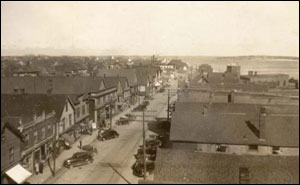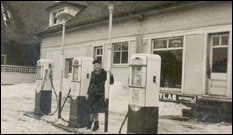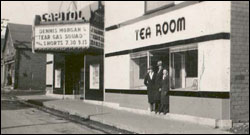The main retailers were long established and well respected firms - R. T. Holman Ltd., Brace, MacKay Co. Ltd., and Sinclair & Stewart Ltd. People from the surrounding countryside came by car, bus, train, or horse and wagon to shop in those large department stores or in the smaller specialized stores. There were several drug stores and jewelry stores, along with an assortment of retail firms. Eating establishments were in abundance. There were four banks and numerous professional offices. Services included laundries, garages, printers, and dairies. Barbers were busy and hairdressers claimed to be "rushed off their feet." The Capitol Theatre, the only movie house in town, thrived with the extra clientele of the air force members. The Airways Bus & Taxi Company ran between the downtown and the RCAF Station.
Many items normally in stock on retail shelves were in short supply or simply unavailable as the war stretched out. Retail merchants were given opportunities for meeting with government officials to learn how to cope with problems. A special speaker from the Management Service Division of the WPTB spoke at Town Hall in June 1943 on the topic "A Wartime Plan for the Retailer." In January 1944, another session was held about market problems and how to deal with them.
Businesses lost staff to the armed forces but carried on serving their customers. Some retail outlets were able to use the wartime situation to handle new goods or offer new services. Others offered explanations for difficulties in providing service. View examples of advertisements of local firms as well as national or regional companies.
Despite shortages and the backdrop of the war, the Christmas shopping season continued as usual. A Journal editorial in 1942 commented on the strong tradition of gift giving. The "bright attire" of local stores was described in the Journal in December 1944 and again in 1945.
Numerous references were made throughout the period to the shortage of parking in the downtown. There was angle parking on both sides of Water Street but at times hardly enough to accommodate the traffic. A visitor to Summerside commented on the cars halfway up on the sidewalks as one of the things he noticed about the town. An editorial in the Pioneer in May 1944 commented, "There appears to be little evidence of gas rationing when the congestion of cars and trucks is noted on our main thoroughfare."
The Water Street area was definitely bustling in the early 1940s, with the busiest retailer being R. T. Holman Ltd. to which a special page has been devoted.
| Related Articles | Related Images | Related Memories | Related Websites | Inflation Calculator |
| Home Page | Site Map | Contact Us | Wyatt Heritage Properties |






